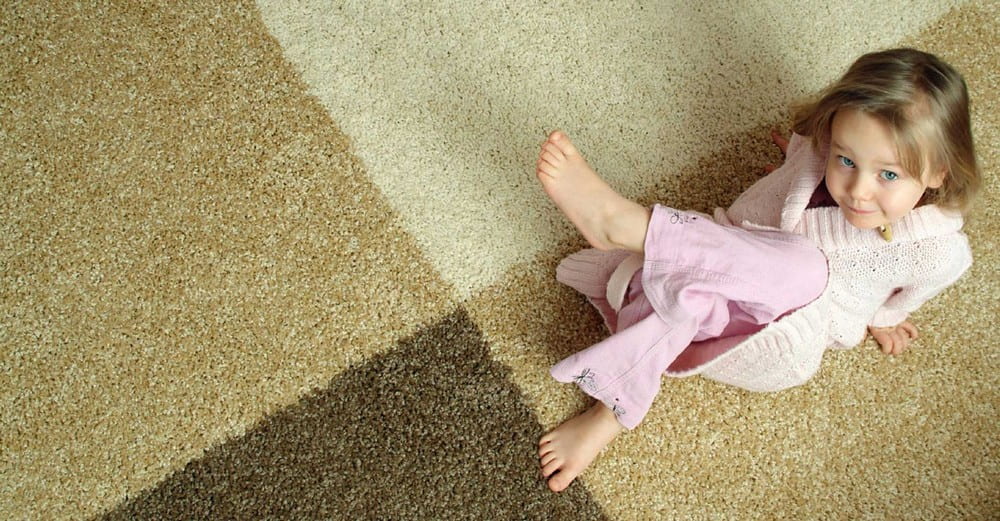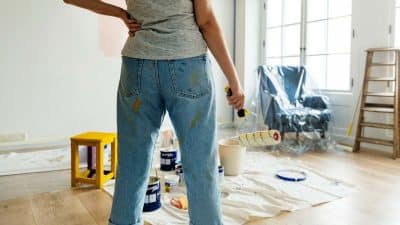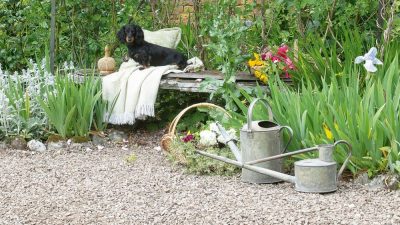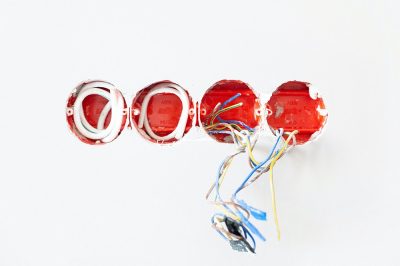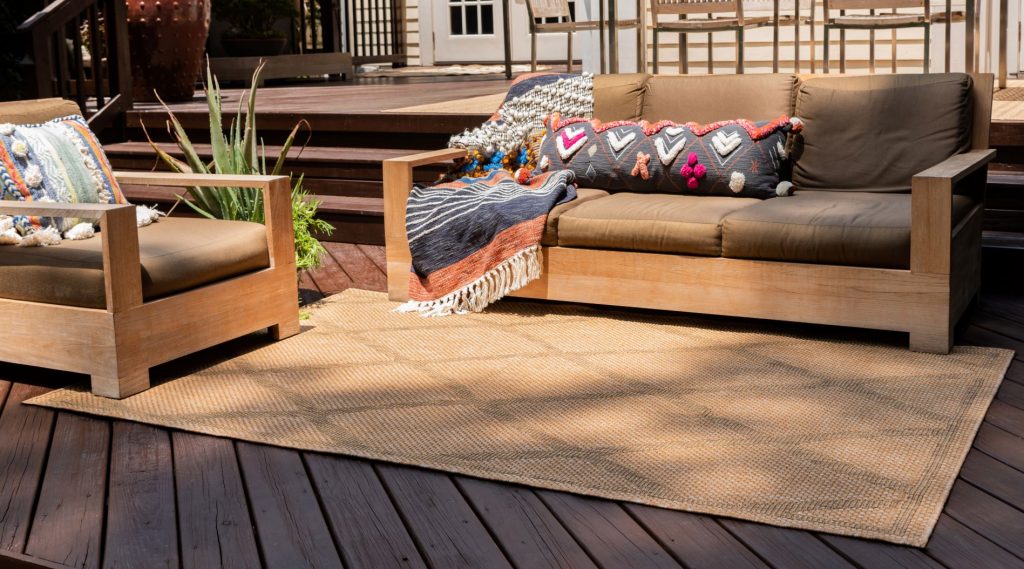
Welcome to the dynamic world of indoor-outdoor carpets, a versatile and practical flooring solution for any space. Unlike regular carpets, these robust floor coverings are designed to endure both the cozy interiors of a home and the harsh elements of the outdoors. However, this versatility comes with unique cleaning challenges. From battling outdoor dirt and weather-related wear to maintaining their aesthetic appeal indoors, the cleaning needs of these carpets are as varied as their uses. In this article, we’ll explore effective strategies for keeping your indoor-outdoor carpets in pristine condition, ensuring they remain a durable and attractive feature in your home or outdoor space.
Understanding Indoor-Outdoor Carpets
Indoor-outdoor carpets are a marvel of modern flooring, offering an unparalleled blend of durability and versatility. At the heart of their resilience lies the choice of materials used in their manufacture. Let’s delve into what makes these carpets stand out and why they have become a popular choice for both residential and commercial spaces.
The Fabric of Durability: Materials Used
1. Polypropylene: This is the most commonly used material in indoor-outdoor carpets. Polypropylene, also known as olefin, is prized for its exceptional resistance to moisture, mildew, and stains. Unlike natural fibers, it doesn’t absorb water, making it ideal for outdoor conditions. It’s also fade-resistant, which means it can endure prolonged exposure to sunlight without losing its vibrant colors.
2. Nylon: Some indoor-outdoor carpets are made with nylon, known for its resilience and ability to retain its shape. This means that even after being compressed under furniture or foot traffic, nylon carpets bounce back to their original form.
3. Polyester: Known for its soft texture, polyester is sometimes used in indoor-outdoor carpets for areas that require a more comfortable underfoot. It’s also resistant to fading and various stains.
4. Recycled Materials: Eco-friendly options often include carpets made from recycled plastics and other sustainable materials. These not only contribute to environmental conservation but also offer durability.
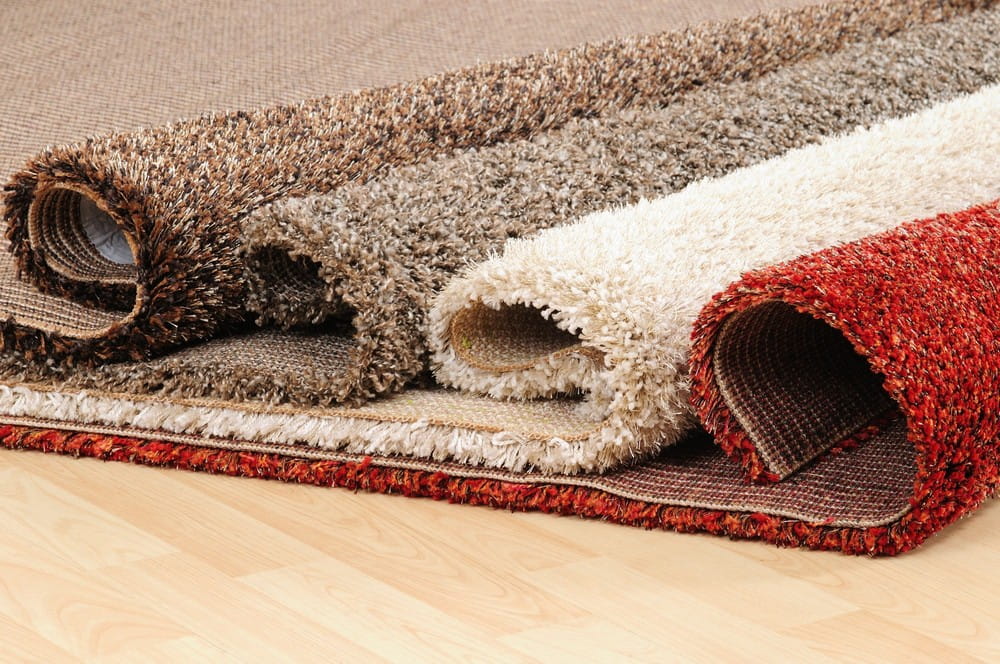
Why They’re a Popular Choice
1. Durability: One of the most significant advantages of indoor-outdoor carpets is their ability to withstand harsh conditions. From heavy rain to intense sunlight, these carpets maintain their integrity and appearance.
2. Low Maintenance: These carpets are designed for easy cleaning. Spills and dirt can often be cleaned with a simple rinse, making them a practical choice for high-traffic areas.
3. Versatility in Design: Today’s indoor-outdoor carpets come in a variety of patterns and colors. This versatility makes them suitable for enhancing outdoor spaces like patios and decks, as well as indoor areas like sunrooms and basements.
4. Resistance to Weather Elements: They are specifically engineered to resist the damaging effects of weather, including UV rays, rain, and extreme temperatures.
5. Cost-Effectiveness: Compared to traditional carpets, indoor-outdoor carpets are often more affordable and offer greater value over time due to their long-lasting nature.
6. Safety Features: Many indoor-outdoor carpets are designed with traction in mind to reduce the risk of slips and falls, making them a safer option for wet or high-traffic areas.
In conclusion, understanding the materials and benefits of indoor-outdoor carpets illuminates why they are an increasingly popular choice for those looking for a practical, stylish, and durable flooring solution. Whether it’s for a cozy balcony or a bustling dining area, these carpets blend functionality with aesthetics to enhance any space.
Pre-Cleaning Preparation for Indoor-Outdoor Carpets
Before diving into the actual cleaning process, preparing your indoor-outdoor carpet correctly is crucial. This stage sets the groundwork for an efficient and effective cleaning routine. Here’s how you can get your carpet ready:
Clearing the Area
Remove Furniture and Objects: Begin by clearing the carpeted area. Move all furniture, plant pots, and any other items off the carpet. This ensures that you have unobstructed access to the entire surface, allowing for a thorough cleaning.
Check for Wear and Tear: Once the area is clear, inspect the carpet for any signs of damage or wear. This can include loose threads, tears, or weakened spots. Identifying these areas beforehand is important to avoid aggravating any damage during the cleaning process.
Safety First: If your carpet is placed on a deck or a balcony, ensure that the surrounding area is safe, especially if you plan to use water or cleaning solutions that could make surfaces slippery.
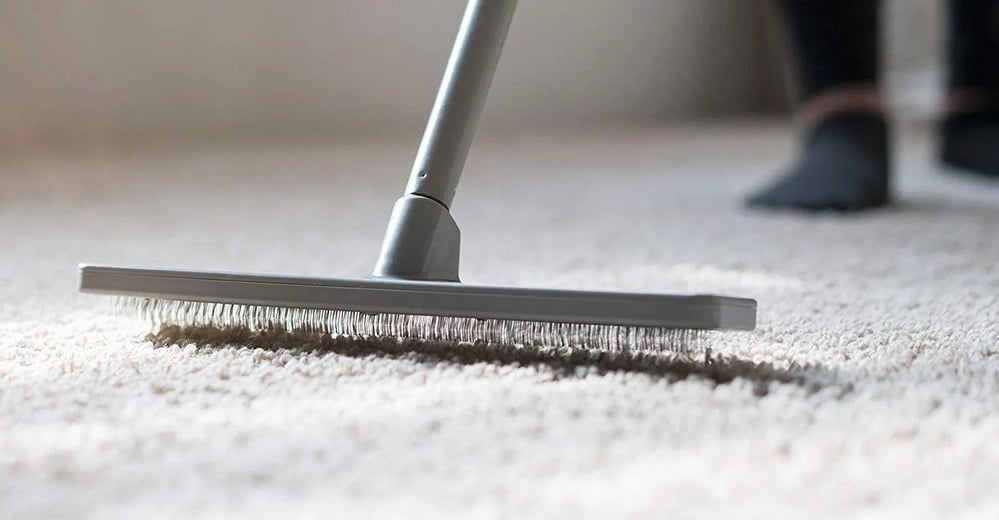
Initial Cleaning
Sweeping: Use a broom with stiff bristles to sweep away debris, leaves, and loose dirt. This is particularly important for carpets that are in outdoor settings. Sweeping not only helps in removing surface dirt but also fluffs up the fibers of the carpet, making it easier to clean deeply.
Vacuuming: If the carpet is located in an indoor or sheltered area, use a vacuum cleaner. Ensure that your vacuum is set to the right height setting for your carpet’s pile to effectively remove dirt without damaging the fibers. For carpets with a lower pile, a lower height setting is ideal.
Dealing with Pet Hair and Larger Debris: If you have pets, use a lint roller or a specialized pet hair vacuum attachment to remove pet hair. For larger debris or leaves, a hand-held brush can be more effective than a vacuum.
Edge Cleaning: Don’t forget to clean along the edges where the carpet meets the wall or other surfaces. This is often a neglected spot where dust and dirt can accumulate.
By following these steps, you prepare your indoor-outdoor carpet for a more intensive cleaning process. Pre-cleaning not only makes the subsequent steps easier but also more effective, ensuring that your carpet is cleaned thoroughly and lasts longer in its pristine condition.
Spot Cleaning Techniques for Indoor-Outdoor Carpets
Spot cleaning is an essential aspect of maintaining indoor-outdoor carpets, especially since they are prone to specific types of stains given their usage. Here’s a step-by-step guide on how to tackle common stains such as mud and food spills, along with recommendations for eco-friendly and carpet-safe cleaning solutions.
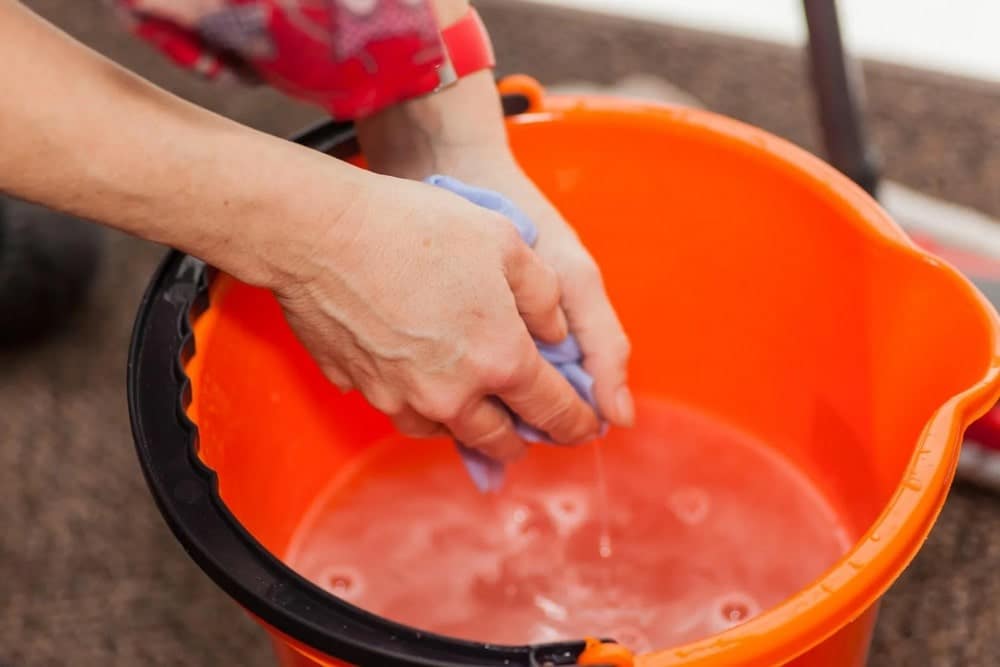
Treating Common Stains
1. Mud Stains:
Let it Dry: Wait for the mud to dry completely. Wet mud is more challenging to remove and can further penetrate the carpet fibers.
Break and Vacuum: Once dry, break up the mud with a brush and then vacuum up the debris.
Apply Cleaning Solution: Mix a solution of mild dish soap and water. Use a sponge or cloth to apply the solution to the stain, dabbing gently.
Blot and Rinse: Blot the area with a clean, damp cloth to remove the soap solution. Do not oversaturate the carpet.
Dry Thoroughly: Allow the area to air dry or use a clean, dry towel to blot excess moisture.
2. Food Spills:
Remove Solids: Gently scrape off any solid food with a spoon or a dull knife.
Blot the Spill: Use a clean, dry cloth to blot the spill. Avoid rubbing, as this can push the stain deeper into the fibers.
Cleaning Solution: Mix a solution of white vinegar and water (1:1 ratio). Vinegar is an effective, eco-friendly cleaner that can help lift food stains.
Apply and Blot: Apply the vinegar solution to the stain and let it sit for a few minutes. Then, blot the area with a damp cloth.
Rinse and Dry: Rinse the area with a clean, wet cloth to remove any vinegar residue. Dry the area with a towel or let it air dry.
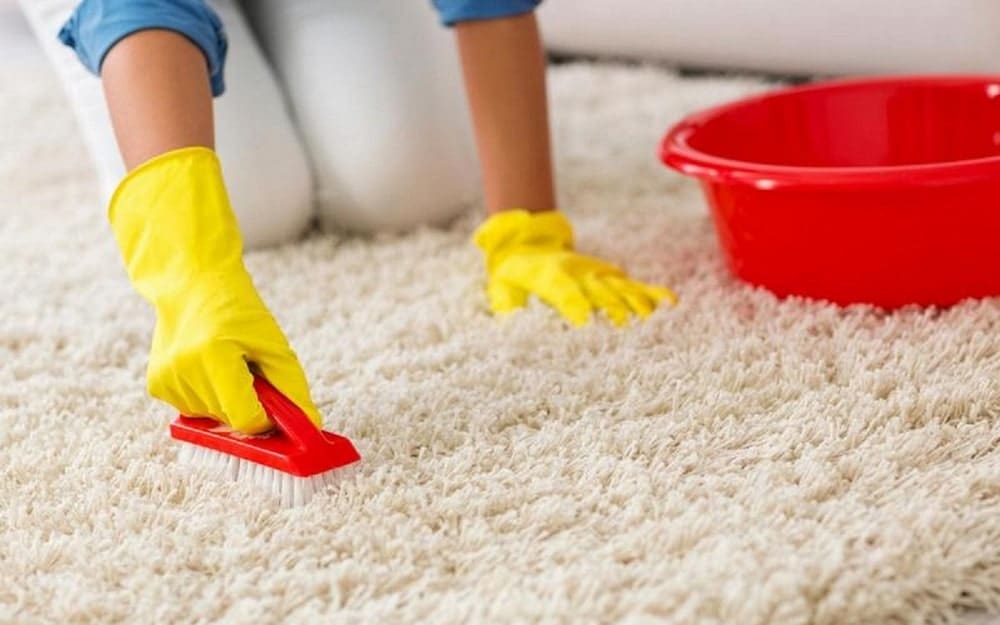
Eco-Friendly Cleaning Solutions
Vinegar and Water Mixture: As mentioned, a mixture of equal parts white vinegar and water can tackle a variety of stains without the use of harsh chemicals.
Baking Soda: For odors or light stains, sprinkle baking soda on the affected area, let it sit for 15-20 minutes, and then vacuum. Baking soda is a natural deodorizer and gentle abrasive.
Mild Dish Soap Solution: A small amount of dish soap mixed with water can be effective for many types of stains. Ensure the soap is dye-free and mild.
Club Soda: Club soda can be effective on fresh stains, especially those that are acidic, like coffee or wine. Blot the stain with club soda on a clean cloth.
Hydrogen Peroxide (Caution): For tougher stains, a 3% hydrogen peroxide solution can be used, but first test it on an inconspicuous area of the carpet as it may lighten the fabric.
When using any cleaning solution, it’s always a good practice to test it on a small, hidden area of the carpet first to ensure it does not cause discoloration or damage. Regular spot cleaning not only keeps your indoor-outdoor carpet looking fresh but also extends its lifespan by preventing stains from setting in permanently. Remember to always blot rather than rub stains and to rinse out any cleaning solutions thoroughly to avoid attracting more dirt.
Deep Cleaning Methods for Indoor-Outdoor Carpets
Deep cleaning your indoor-outdoor carpet is essential for maintaining its appearance and extending its lifespan. There are several methods to consider, each with its own set of advantages. Here, we’ll explore two popular methods: steam cleaning and power washing, along with safe and effective instructions for each.
1. Steam Cleaning
What is Steam Cleaning?
Steam cleaning, also known as hot water extraction, involves using hot water and cleaning agents to deep clean carpet fibers.
It’s effective in removing ingrained dirt and sanitizing the carpet.
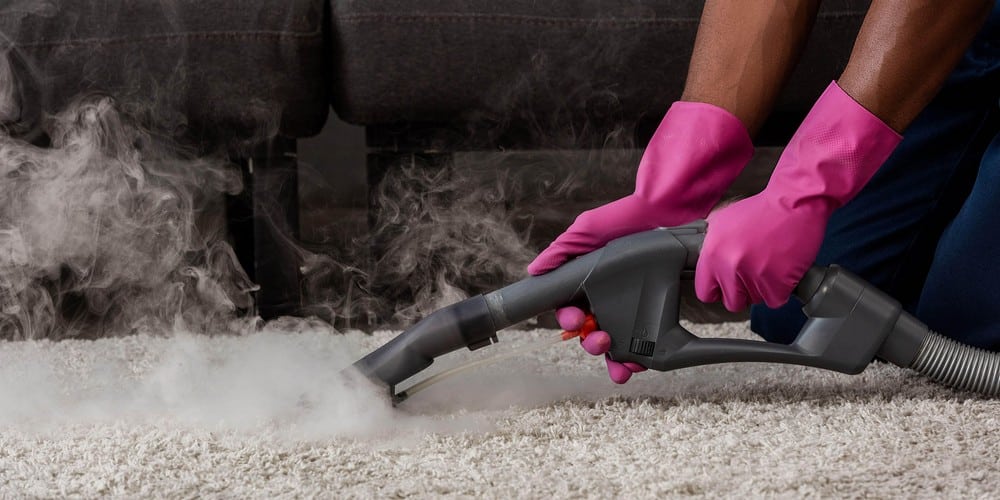
Advantages
Deeply penetrates carpet fibers, removing more dirt and bacteria.
No harsh chemicals are needed, making it environmentally friendly.
Leaves minimal residue compared to shampooing.
How to Steam Clean
- Preparation: Vacuum the carpet thoroughly to remove loose dirt.
- Steam Cleaner Setup: Fill the steam cleaner with hot water and a suitable carpet cleaning solution.
- Cleaning: Move the steam cleaner over the carpet in a systematic manner, ensuring even coverage. Avoid over-wetting the carpet.
- Drying: Allow the carpet to dry completely, which may take several hours. Ensure good ventilation or use fans to speed up the process.
2. Power Washing
What is Power Washing?
Power washing uses high-pressure water spray to remove dirt, grime, and stains from surfaces.
Suitable for carpets that are heavily soiled and located in outdoor areas.
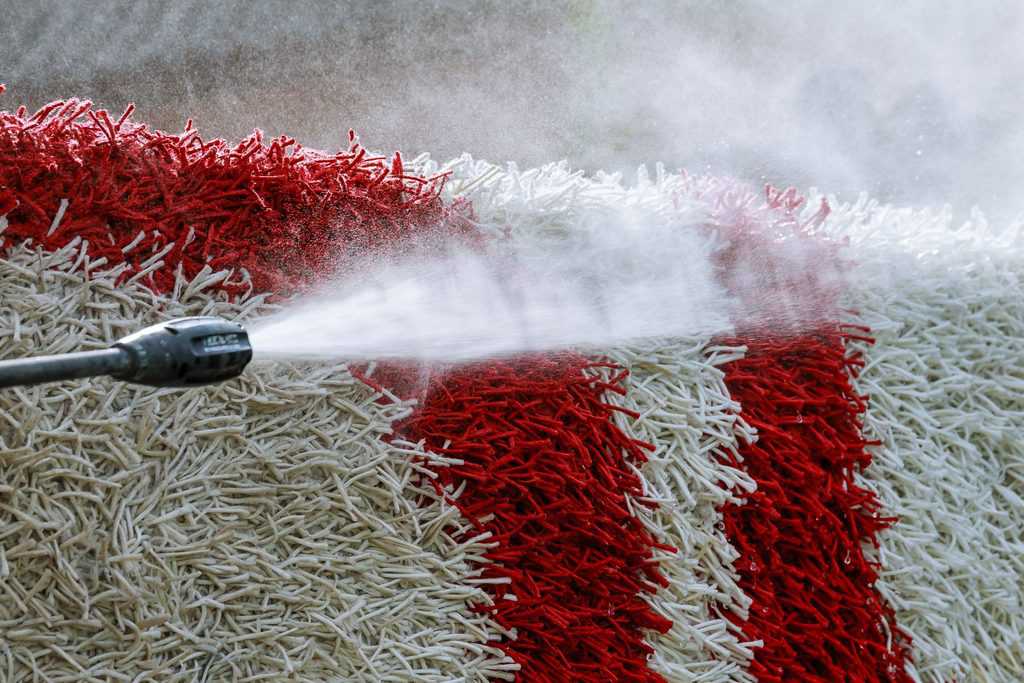
Advantages
Highly effective for removing tough stains and outdoor grime.
Quick and efficient for large areas.
How to Power Wash
- Preparation: Remove all furniture and objects from the carpet. Sweep or vacuum to remove loose debris.
- Setting Up: Use a power washer with a suitable nozzle and pressure setting. Too high pressure can damage the carpet fibers.
- Cleaning: Spray the carpet with water, keeping the nozzle at a consistent distance. Use a back-and-forth motion and try to cover the carpet evenly.
- Rinsing and Drying: Rinse the carpet thoroughly with clean water. Allow it to dry completely before placing furniture back on it.
3. Safety and Effectiveness Tips
Test First: Always test a small, inconspicuous area before applying any cleaning method to the entire carpet.
Avoid Over-wetting: Both methods can introduce a lot of water into the carpet. Ensure that the carpet is not overly saturated and is dried thoroughly afterward to prevent mold and mildew growth.
Chemical Use: Be cautious with cleaning chemicals. Opt for eco-friendly, carpet-safe options whenever possible.
Regular Maintenance: Deep cleaning is most effective when done regularly, as part of a maintenance routine, rather than waiting until the carpet is heavily soiled.
Both steam cleaning and power washing can be effective for deep cleaning indoor-outdoor carpets, each with their unique strengths. Steam cleaning is generally more suitable for indoor or delicate carpets, whereas power washing is ideal for robust outdoor carpets exposed to harsher conditions. Whichever method you choose, following these instructions will ensure that your carpet is cleaned safely and effectively, preserving its quality and appearance.
Drying and Post-Cleaning Care for Indoor-Outdoor Carpets
Proper drying and post-cleaning care are crucial steps in maintaining the integrity and appearance of your indoor-outdoor carpet. Here are some tips and advice to ensure your carpet dries completely and looks its best after cleaning.
Ensuring Complete Drying
1. Adequate Ventilation: Increase air circulation in the area where the carpet is drying. If indoors, open windows or use fans. For outdoor carpets, choose a sunny day for cleaning to take advantage of natural drying conditions.
2. Elevate the Carpet: If possible, elevate the carpet off the ground to allow air to circulate underneath. This can be done using blocks or racks, especially for outdoor carpets.
3. Roll and Squeeze for Excess Water: For very wet carpets, gently roll the carpet and press to squeeze out excess water. Be careful not to twist the carpet, as this can damage the fibers.
4. Use Towels for Absorption: Lay absorbent towels over the surface of the carpet and press gently to soak up water. Change the towels as they become damp.
5. Check for Dryness: Before returning the carpet to use, ensure it is completely dry to the touch, including both the top fibers and the backing. This is crucial to prevent mold and mildew growth.
Restoring the Carpet’s Appearance
1. Gently Fluff Fibers: After the carpet is dry, use your hands or a soft brush to gently fluff up the fibers. This helps in restoring the texture and look of the carpet that might have been flattened during the cleaning process.
2. Brush in the Right Direction: For carpets with a grain, make sure to brush the fibers in the direction of the grain for a uniform appearance.
3. Trim Snags Carefully: If you notice any snags or loose threads after cleaning, carefully trim them with scissors. Avoid pulling on them, as this can cause further damage.
4. Address any Remaining Odors: If there’s any lingering odor, sprinkle baking soda on the dry carpet, let it sit for 15-20 minutes, and then vacuum. Baking soda is an effective natural deodorizer.
5. Regular Maintenance: Post-cleaning is a good time to implement or review a regular maintenance schedule for your carpet. Regular vacuuming, prompt spot cleaning, and periodic deep cleaning can greatly extend the life and appearance of your carpet.
By ensuring that your indoor-outdoor carpet dries thoroughly and taking steps to restore its appearance post-cleaning, you can keep it looking fresh and vibrant for years to come. These practices not only preserve the aesthetic of your carpet but also prevent issues like mold and mildew, which are crucial for the health and hygiene of your space.
Preventive Maintenance and Regular Care for Indoor-Outdoor Carpets
To keep your indoor-outdoor carpet in top condition, preventive maintenance and regular care are key. These strategies not only help minimize dirt and wear but also extend the carpet’s lifespan and maintain its appearance. Here’s how you can effectively care for your carpet:
Strategies to Minimize Dirt and Wear
Use Doormats: Place doormats at all entrances to reduce the amount of dirt and debris tracked onto the carpet. Encourage everyone to wipe their feet before entering.
Routine Vacuuming: Regular vacuuming is crucial, especially in high-traffic areas. It prevents the build-up of dirt and grime that can wear down carpet fibers over time. Vacuum at least once a week, or more frequently in areas with heavy foot traffic.
Immediate Spot Cleaning: Address spills and stains immediately to prevent them from setting in and becoming more difficult to remove.
Rearrange Furniture Periodically: Regularly changing the layout of your furniture can prevent excessive wear and tear in specific areas of the carpet.
Limit Direct Sunlight: Prolonged exposure to direct sunlight can cause fading. Use blinds or curtains to minimize this effect, especially for indoor carpets.
Proper Footwear: Encourage the use of appropriate footwear indoors to prevent unnecessary wear on the carpet.
Schedule for Regular Cleaning
Weekly Vacuuming: Vacuum the carpet weekly to remove surface dirt and dust. Use a vacuum cleaner with a setting appropriate for the pile height of your carpet.
Monthly Deep Cleaning: Depending on the usage and location, aim for a deeper clean, such as steam cleaning or washing, at least once a month.
Bi-Annual Professional Cleaning: Consider professional cleaning services twice a year for a thorough deep clean. This is particularly beneficial for carpets in high-traffic areas or those exposed to harsh outdoor elements.
Seasonal Checks: At the start of each season, inspect your carpet for any signs of damage or wear. This can include loose fibers, fading, or mildew growth. Addressing these issues early can prevent more significant problems.
Post-Event Cleaning: After hosting events or parties, especially in outdoor areas, give your carpet an extra round of cleaning to tackle any spills or increased foot traffic.
By adhering to these preventive maintenance and regular care strategies, you can significantly prolong the life and preserve the appearance of your indoor-outdoor carpet. Consistent care not only keeps your carpet looking its best but also ensures a healthy and clean environment in your home or outdoor space.
Troubleshooting Common Issues with Indoor-Outdoor Carpets
Indoor-outdoor carpets can encounter a range of issues due to their exposure to different environments and conditions. Here are some solutions for tackling common problems such as persistent odors, discoloration, and water damage. Additionally, understanding when to seek professional cleaning services can help in maintaining the longevity and appearance of your carpet.
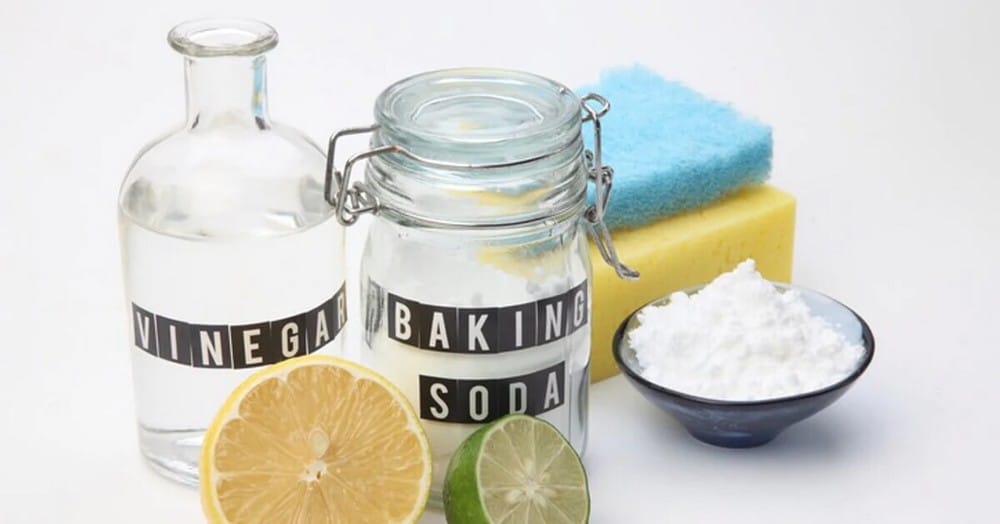
Addressing Persistent Odors
Baking Soda Treatment: Sprinkle baking soda over the entire carpet and let it sit for a few hours or overnight. Vacuum it up afterward. Baking soda is a natural odor neutralizer.
Vinegar Solution: Mix equal parts water and white vinegar in a spray bottle. Lightly mist the solution over the carpet and allow it to air dry. Vinegar is effective in neutralizing odors, and the vinegar smell will dissipate as it dries.
Sunlight Exposure: If possible, expose the carpet to sunlight for a few hours. Sunlight is a natural deodorizer and can help eliminate bacteria causing the odor.
Tackling Discoloration
Identify the Cause: Determine what caused the discoloration. Is it due to a spill, sun fading, or a cleaning product?
Spot Cleaning: For localized stains, use a carpet-safe cleaner. Always test any cleaning solution on a small, inconspicuous area first.
Avoid Harsh Chemicals: Harsh chemicals can cause further discoloration. Stick to mild detergents and ensure you rinse them out thoroughly.
Professional Assessment: If discoloration is widespread or the cause is unknown, consider consulting a professional carpet cleaner.
Managing Water Damage
Immediate Action: Address water spillage or flooding immediately. The longer the carpet stays wet, the higher the risk of mold and mildew.
Water Extraction: Use a wet-dry vacuum to remove as much water as possible.
Air Circulation: Improve air circulation with fans or dehumidifiers to speed up the drying process.
Check Underneath: Ensure the surface beneath the carpet is also dry to prevent mold growth.
Professional Help for Severe Cases: In cases of severe water damage, professional carpet cleaners have the necessary equipment and expertise to effectively restore the carpet.
When to Seek Professional Cleaning Services
Stubborn Stains and Odors: If home remedies fail to remove persistent stains or odors, professional cleaners can often resolve these issues.
Regular Deep Cleaning: Even with routine maintenance, it’s advisable to have the carpet professionally cleaned once or twice a year.
After a Significant Water Incident: Professional services are recommended after flooding or major water spills to ensure thorough drying and prevent mold.
When Damage is Beyond DIY Repair: If the carpet shows signs of significant wear, tear, or damage, professional assessment and treatment might be necessary.
By understanding these troubleshooting tips and knowing when to seek professional help, you can effectively address common issues associated with indoor-outdoor carpets. Regular maintenance combined with prompt attention to problems helps maintain the beauty and functionality of your carpet for years to come.
Conclusion
In conclusion, maintaining your indoor-outdoor carpet requires a blend of routine care, timely intervention for spills and stains, and understanding the right cleaning methods. From pre-cleaning preparations like removing furniture and vacuuming, to spot treating common stains with eco-friendly solutions, each step plays a crucial role in preserving the carpet’s appearance and longevity. Deep cleaning techniques like steam cleaning or power washing extend the carpet’s life, while proper drying and post-cleaning care prevent mold and mildew. Regular maintenance, including vacuuming and immediate stain removal, along with periodic professional cleaning, ensures the carpet remains a durable and attractive part of your living space. Remember, the effort you put into maintaining your indoor-outdoor carpet not only enhances its functionality and beauty but also contributes to a healthier, cleaner environment in your home.
